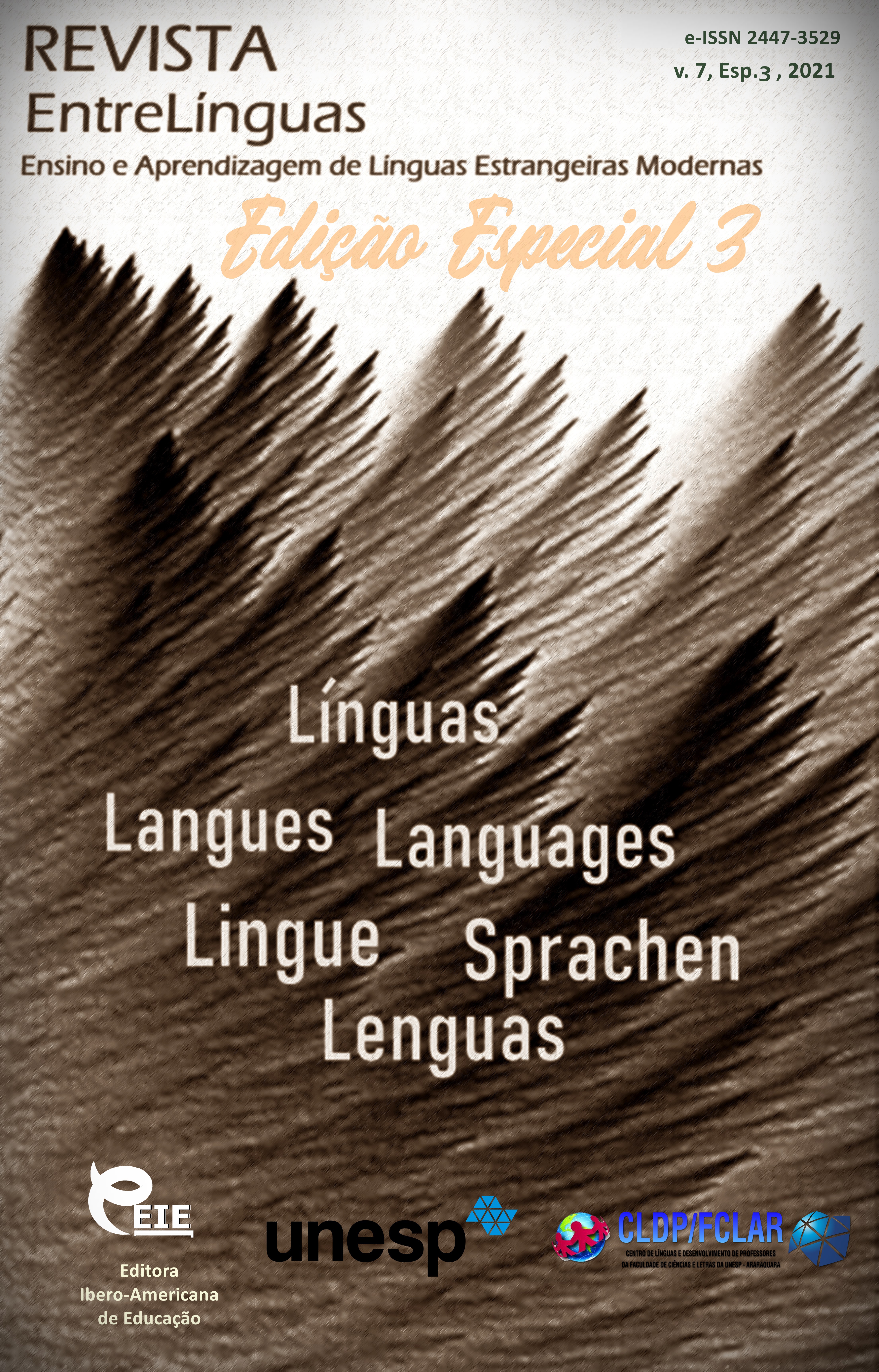Técnicas tradicionales y digitales para trabajar con material léxico en clases de inglés
DOI:
https://doi.org/10.29051/el.v7iesp.3.15731Palabras clave:
Comunicación, Lengua extranjera, Estudiantes, Discurso, Competencia comunicativaResumen
La relevancia de este estudio se debe al hecho de que la habilidad léxica es parte integral de todo tipo de actividad del habla, cuya formación, mejora y desarrollo es la tarea principal de la enseñanza de una lengua extranjera, a saber, el inglés. Los autores se centran en la necesidad de un buen conocimiento del vocabulario para el desarrollo exitoso de la competencia comunicativa de los estudiantes en un mundo globalizado. El propósito de este estudio es examinar el proceso de formación de la competencia lingüística al enseñar un idioma extranjero y revelar qué técnicas son más adecuadas para los estudiantes de pre-intermedio e intermedio según la investigación realizada entre los estudiantes de primer año en Kazan Federal. Universidad. Sobre la base del análisis de métodos efectivos para introducir vocabulario en las clases de inglés, los autores identificaron 10 estrategias para el aprendizaje efectivo del vocabulario y compararon los métodos tradicionales y digitales de su introducción y práctica. Los autores de este artículo prestan especial atención a la experiencia de activar el aprendizaje de nuevo vocabulario en las clases de inglés. Se sugieren ejemplos de ejercicios léxicos típicos de cada etapa del trabajo con el vocabulario. Se extraen conclusiones basadas en la encuesta a 213 estudiantes.
Descargas
Citas
ABROSIMOVA, G. A. et al. Blended learning in university education. Humanities & Social Sciences Reviews, v. 7, n. 6, p. 6-10, 2019.
ANTONACCI, P. A.; O’CALLAGHAN, C. M. Promoting literacy development: research-based strategies for K-8 learners. California: SAGE Publications, Inc., 2011. 167 p.
BAUMANN, J.; WARE, W. E. Edwards, bumping into spicy, tasty words that catch your tongue: A formative experiment on vocabulary instruction. The Reading Teacher, n. 61, p. 108-122, 2007.
BUCKOWIECKI, E.M. Vocabulary instruction: advice to new teachers. New England Association Journal, v. 2, n. 42, p. 29-40, 2006.
COSKIE, T. L.; DAVIS, K. J. Word wall work: Supporting science talk. Science and Children, v. 46, n. 8, p. 56-58, 2009.
CUNNINGHAM, P. Phonic they use: words for reading and writing. 3. ed. New York: Longman-Addison Wesley, 2000. 232 p.
EREMEEVA, G. R. Dialogization of professional communication between students and lecturers. Journal of Organizational Culture, Communications and Conflict, n. 20, p. 128-134, 2016.
HARMON, J. M. et al. Interactive word walls: more than just reading the writing on walls. Journal of Adolescent & Adult Literacy, n. 52, p. 389-408, 2009.
HENRICHS, E. L. Interactive word walls and student perceptions of vocabulary. Texas State University, 2011. Available: https://digital.library.txstate.edu/handle/10877/2473. Access: 04 June 2020.
HILDEN, K.; JONES, J. Classroom word walls: is yours a tool or a decoration? Reading Today, v. 29, n. 4, p. 9-11, 2012.
JACKSON, J. K. Interactive, conceptual word walls: Transforming content vocabulary instruction one word at a time. International Research in Education, v. 2, n. 1, p. 37-46, 2014.
JACKSON, J.; NARVAEZ, R. Interactive word walls: create a tool to increase science vocabulary in five easy steps. Science and Children, v. 51, n. 1, p. 42-49, 2013.
KENT, M. A. The effect of systematic word wall instruction on the literacy achievement of first grade students. UMI No. 30558, 2006. 176 p.
KHUSAINOVA, R. R.; VALEEV, A. A. Technological aspect of the development of university students foreign language activities. Astra Salvensis, n. 6, p. 746-764, 2018.
KONDRATEVA, I.; SABIROVA, D.; PLOTNIKOVA, N. Subjectivity functions in reflexive and intercultural process of linguistic development. Cypriot Journal of Educational Sciences, v. 13, n. 4, p. 529-536, 2018.
KUVSHINOV, V. I. About work with vocabulary in school. Foreign Languages at School, n. 5, p. 20-24, 2015.
KUZNETSOVA, T. M. Stages of work on the word. Foreign Languages at School, n. 5, p. 88-94, 2011.
MAY, B. Will using a classroom word wall help students successfully learn high frequency words? Winona State University Anthology of k-12 language arts action research, ERIC document Reproduction Service, ED 494233. 2004.
ROGOVA, G. V. RABINOVICH, F. M.; SAKHAROV, T. E. Methods of teaching foreign languages in secondary school. Moscow: Education, 2011. 254 p.
SHAKIRZYANOVA, R. M.; ZAKIROVA, R. R. The creativity development of teenagers in leisure time. Humanities & Social Sciences Reviews, v. 7, n. 6, p. 76-80, 2019.
SOLOVYOVA, E. N. Methods of teaching foreign languages. Basic course of lectures / manual for students and teachers in ped. Universities. Moscow: Education, 2012. 321 p.
VALEEV, A. A. et al. Major areas of foreign language speech activity of university students improvement. Humanities & Social Sciences Reviews, v. 7, n. 6, p. 967-977, 2019.
YATES, P.; CUTHRELL, K.; ROSE, M. Out of the room and into the hall: making content word walls work. The Clearing House: A Journal of Educational Strategies Issues and Ideas, v. 84, n.1, p. 31-36, 2011.
Publicado
Cómo citar
Número
Sección
Licencia

Esta obra está bajo una licencia internacional Creative Commons Atribución-NoComercial-CompartirIgual 4.0.
Os manuscritos aceitos e publicados são de propriedade da Revista EntreLínguas. Os artigos publicados e as referências citadas na Revista EntreLínguas são de inteira responsabilidade de seus autores.
Transferência de direitos autorais – autorização para publicação
Caso o artigo submetido seja aprovado para publicação, já fica acordado que o(s) autor(es) autoriza(m) a UNESP a reproduzi-lo e publicá-lo na EntreLínguas, entendendo-se os termos “reprodução” e “publicação” conforme definição respectivamente dos incisos VI e I do artigo 5° da Lei 9610/98. O artigo poderá ser acessado pela rede mundial de computadores (Internet), sendo permitidas, a título gratuito, a consulta e a reprodução de exemplar do artigo para uso próprio de quem a consulta, desde que haja a citação ao texto consultado. Essa autorização de publicação 328 EntreLínguas, Araraquara, v. 1, n .2, p. 323-328, jul./dez. 2015 não tem limitação de tempo, ficando a UNESP responsável pela manutenção da identificação do(s) autor(es) do artigo. Os artigos publicados e as referências citadas na Revista EntreLínguas são de inteira responsabilidade de seus autores.











